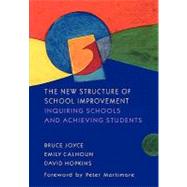
Note: Supplemental materials are not guaranteed with Rental or Used book purchases.
Purchase Benefits
What is included with this book?
| Foreword | xi | ||||
|
|||||
| Mission and style | xiii | ||||
| PART I CREATING THE SCHOOL AS A CENTER OF INQUIRY: SEARCHING FOR A NEW STRUCTURE | |||||
|
|||||
|
5 | (12) | |||
|
|||||
|
17 | (15) | |||
|
|||||
|
32 | (19) | |||
|
|||||
| PART II ELABORATING THE HYPOTHESES: THE DETAILED WORK OF SCHOOL IMPROVEMENT | |||||
|
|||||
|
51 | (9) | |||
|
|||||
|
60 | (23) | |||
|
|||||
|
83 | (30) | |||
|
|||||
|
113 | (22) | |||
|
|||||
| PART III REFINING, RENOVATING, AND REDESIGNING: TAKING STEPS LARGE AND SMALL | |||||
|
|||||
|
135 | (13) | |||
|
|||||
|
148 | (8) | |||
|
|||||
|
156 | (47) | |||
|
|||||
| PART IV POLICYMAKING FOR SCHOOL RENEWAL: MAKING THE CONTEXT THROUGH NATIONAL, STATE, AND LOCAL EDUCATION AUTHORITY POLICY | |||||
|
|||||
|
203 | (6) | |||
|
|||||
|
209 | (15) | |||
|
|||||
| Coda: history and current context | 224 | (4) | |||
| Bibliography | 228 | (27) | |||
| Index | 255 |
The New copy of this book will include any supplemental materials advertised. Please check the title of the book to determine if it should include any access cards, study guides, lab manuals, CDs, etc.
The Used, Rental and eBook copies of this book are not guaranteed to include any supplemental materials. Typically, only the book itself is included. This is true even if the title states it includes any access cards, study guides, lab manuals, CDs, etc.